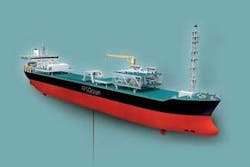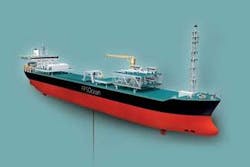Dynamically positioned FPSO broadens options for ultra deep production
FPSOcean has identified a market need for a dynamically positioned FPSO for deepwater production operations. By year-end, the company hopes to have a production contract in place for its first DP FPSO, which will be ready for operation in 1Q 2008.
FPSOcean, which has a goal of developing a fleet of five DP FPSO units over the next four to six years, is based on a small team with plenty of offshore, and especially FPSO, experience. It includes CEO Georg Sverdrup Onsrud who worked for Fred Olsen Production for nine years; Leif O Aaker, vice president of business development, formerly of Golar-Nor Offshore, owner and operator ofPetrojarl 1, the first ever FPSO; and chairman Erland Bassøe, who gives his name to the Bassøe Offshore rig brokerage and is a well-known investor and director of offshore companies.
The need for new station-keeping solutions for FPSOs operating in very deep waters is a natural consequence of increased exploration in very deep waters. “After the deepwater drilling wave comes the deepwater production wave,” says Onsrud, noting that drilling in waters of 10,000 ft (3,048 m) is not so uncommon.
As water depths increase, conventional FPSO mooring systems become costlier and eventually impractical. The DP FPSO offers a practical alternative, according to FPSOcean, which is targeting its concept at the major deepwater provinces of the Gulf of Mexico, Brazil, West Africa and Far East.
Experience of FPSOs operating on DP is limited but encouraging, Onsrud says - theSeillean DP production ship has been a great success for Petrobras in the Campos basin, for example.
DP station-keeping normally is perceived as an expensive operation, requiring frequent thruster operations to maintain position and engines permanently running to power the thrusters. However, Onsrud points out that the mooring cost for an FPSO in deep waters also is substantial, amounting to several 10s of millions of dollars without considering the cost of the turret and end-contract demobilization.
FPSOcean’s concept, developed in consultation with potential customers, involves risers accessing the ship via a buoy attached inside the hull. For this purpose, FPSOcean has developed jointly with Scana Industrier the concept of the disconnectable riser buoy (DRB). While the DRB is geostationary, a bearing system enables the ship to rotate around it using hydraulic drive.
Installation on the field is simple compared with a moored FPSO: once the ship reaches the designated location, the DP system is activated and tested, and the ship is then considered installed.
The buoy itself is pulled into a conical-shaped bay in a midship moonpool by a heave-compensated winch - this ensures that no clashing takes place, says Aaker. It is secured in place by locking dogs.
The attachment of the flexible risers to the buoy takes place with the aid of a support vessel and ROV. Each riser in turn is lifted from the seabed by a line attached to the support ship’s crane. A line paid out through the buoy then is attached by the ROV to the riser, which then is pulled into the buoy.
Hook-up on the field is straightforward and relatively rapid. “We’ve got the most cost-effective system for installation,” claims Onsrud.
The DRB has been designed for emergency disconnection, for example in the event of total power failure on the vessel. In this case, once the wells have been shut in, the buoy is released from the locking dogs - its buoyancy is such that it sinks to 40-70 m (131-230 ft) below the sea surface. In the event of an early hurricane warning, the wells are shut in and the buoy suspended beneath the vessel - if the hurricane is on course to pass over the field, the vessel disconnects from the buoy and moves to safety.
The first FPSOcean DP production ship will be converted from the 1981-built Panamax shuttle tankerNordic Laurita, which the company acquired last year. The $180-million conversion will be carried out at Dubai Drydocks, which the vessel will enter in May, and is scheduled to be completed by year-end. As an FPSO, the ship will have 480,000 bbl storage, 60,000 b/d liquids handling capacity, and 40,000 b/d oil production capacity, plus facilities for water and gas injection.
The buoy, for which Scana has EPC responsibility, will be 13 m (42.65 ft) high and have a diameter of 9 m (29.5 ft). It will have seven slots to accommodate three 8-in. (203 mm) production risers, one 8-in. (203 mm) injection water riser, one 6-in. (152 mm) gas-lift/service riser, and two control/service umbilicals.
Power generation for production and DP operations will be provided by two 17 MW dual-fuel gas turbine power generators from Siemens. The existing propulsion system will be maintained. Accommodation will be provided for 60 crew. Kongsberg will supply the DP-II system and Schottel the four 3.8 MW azimuth thrusters. The existing bow tunnel thruster will be retained.
Management of production operations has been out-sourced to Bibby Offshore of Aberdeen, and Alliance Marine Services.
FPSOcean was received well when it went to the financial market last year, raising $91 million in equity and $75 million through a bond issue. The company now has the resources to finance the conversion of the first vessel and to acquire a second.

